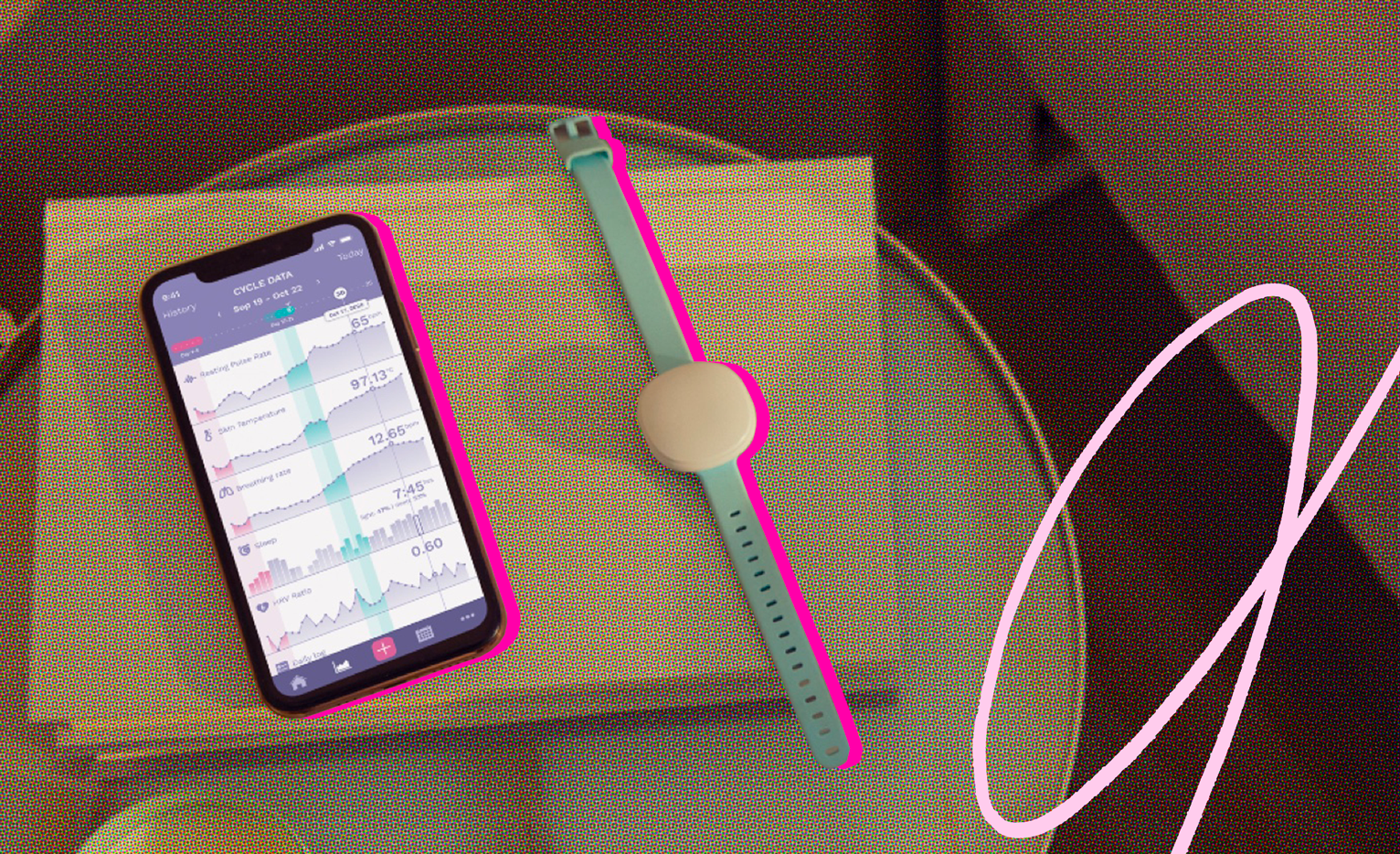Deciding to have kids is one of the biggest decisions someone can make outside of like, getting bangs. And while sex ed made it seem like you’ll get pregnant the first time you have sex, that’s not exactly how it goes for most couples.
“For some, conception can be a short road and for others, it can be a longer journey,” says Banafsheh Kashani, M.D., a double board-certified OB/GYN and reproductive endocrinology/infertility specialist. And if you’re not a part of the “we got magically pregnant the first time we didn’t use birth control” club, trying to conceive (or “TTC” as the fertility community calls it) can be extremely time-consuming and stressful. That, my friends, is where fertility trackers come in.
Why do you need trackers? Glad you asked. You see, there’s a decent chance it’ll be a little before you conjure up a positive pregnancy test. According to board-certified OB/GYN, Shieva Ghofrany, M.D., taking up to 12 months for healthy couples under the age of 35 to get pregnant is completely normal. “Couples should not get worried or feel that they *have* to see a fertility doctor unless it brings them peace of mind,” she says. “If you’re 35+, try for up to six months before seeking help.”
Fertility trackers come into the picture because they help pinpoint when you’re ovulating so you have the best shot of getting pregnant each month. This can shorten the length of time you’re trying because you’re literally making sure all the odds are in your favor.
But before throwing the best suggestions your way, we’ve enlisted the experts to answer a couple of the most pressing TTC questions so you don’t have to spend endless hours in pregnancy forums, attempting to decipher answers from people who can’t spell!
When, Exactly, Can Someone Get Pregnant?
Okay, so first things first, Dr. Kashani says you can, in theory, get pregnant at any time during your menstrual cycle, even during or just after your period. This is because sperm can live up to five days (maybe even more) after having sex, and depending on when you ovulate that month, well, you do the math.
That said, most people ovulate (the process where a mature egg travels down the fallopian tube to, potentially, be fertilized) sometime between 12 and 16 days after their period starts. While you might think you should just have sex on the day of ovulation, that’s actually not your best bet for putting a bun in the oven. Instead, Dr. Shieva says you want to time sex to happen during your fertile window to give your egg the best shot of meeting a little spermy. This window—which spans the five days leading up to ovulation, ovulation day, and the day after—is when you can actually conceive.
So How Can I Tell When I’m Ovulating?
With all of the importance being placed on the mythical ovulation date, figuring out when that happens is sort of key here. Physically, Dr. Kashani says you might feel period-like symptoms along the lines of cramps, breast tenderness, bloating, and headaches when you ovulate. Dr. Shieva also adds that your discharge might get a little tackier in the days leading up to ovulation and on the day of.
Truthfully, though, it’s sometimes hard to figure out WTF your body is saying. Is the headache because you’re ovulating or because you haven’t had any water for the last three hours? Are your boobs sore or is that just what it feels like to have boobs? To take some of the guesswork out of things, people use—you guessed it—fertility trackers and ovulation tools to better determine when their egg is making its monthly escape.
The 9 Best “Trying to Conceive” Products On the Market
If you’re trying to get pregnant, ovulation trackers and fertility products are, hands down, the best beginning tools out there. While these aren’t a fix-all, they will give you the best shot each month to either a) get you knocked up or b) give your doctor more information as to the next best steps to take.
And as someone who personally struggled to conceive after a miscarriage, I tried just about every device, supplement, and test imaginable before getting pregnant again. Ranging from wearable trackers to daily cookies that boost your system, here are the best TTC products that’ll give you a little bit of control during an extremely vulnerable time.
Best Fertility Thermometer: Daysy
Easy to use and totally non-invasive, special oral thermometers designed to track your basal body temperature are one of the simplest ways to accurately detect your fertile window. “Your temperature rises by approximately 1/2 a degree to 1 degree just after ovulation,” explains Dr. Kashani. “This occurs after the oocyte (egg) is released from the ovary, and as the ovary starts producing a hormone called progesterone.”
Technically, the Daysy thermometer can be used as contraception or for TTC, which means you can get multiple uses out of the device depending on where you’re at in life. Basically, you take your temperature the second you wake up—like before getting out of bed—and it tells you whether you’re fertile, possibly fertile, or not fertile that day. Daysy pairs with a (free!) app that charts your data, making it easy to see patterns in your cycle. It was this chart, in fact, that made me (rightfully) suspect I was pregnant again because instead of dropping on the day I should have gotten my period, my temperate remained elevated. Cool, right?
Best Wearable Fertility Tracker: Ava
If you don’t think you’ll remember to take your temperature at the same time every day, or you want even more science involved to doubly make sure you’re ovulating, Ava is for you. This celebrity-beloved, FDA-cleared tracker analyzes five different data points to decipher your fertile window, ovulation day, and when your period will start. It can also confirm whether or not you’re actually ovulating (some people have anovulatory cycles where no egg is released), which is important info you can take with you to the doctor.
It’s also the easiest to use since Ava looks like any other fitness tracker. You literally just put it on your wrist at night, go to sleep, and take it off in the morning. It monitors things like your temperature, your heart rate (which elevates during ovulation), and your breathing rate, and puts all the info on an easy-to-understand—and well-explained—graph in the app. This device also had me rightfully suspecting I was pregnant since it kept pushing out my “expected” period date.
Best Fertility Testing Kit: Modern Fertility
As previously mentioned, it can take up to a year for healthy couples under the age of 35 to conceive. That said, after a few months, you might be getting restless and start googling fertility clinics near you. Instead of spending all that time and money before you even know if it’s necessary, try a home fertility testing kit—like this one from Modern Fertility—first.
These work similarly to tests you’d get done in a lab, but they’re way cheaper and more convenient. This one involves collecting a blood sample at home (like, a few drops) and sending it off to check for the most important hormones involved in fertility. After a few days (which is way faster than tests from a standard clinic), you get your results and the option to talk to a specialist to go over them. Depending on what your report shows, Dr. Kashani says this can give your doctor insight on whether to move forward with other tests, take some proactive measures, and/or prescribe medications like progesterone supplements to help you sustain a pregnancy.
Best Ovulation Testing Kit: Easy@Home Ovulation Test Strips
LH stips—which measure the levels of luteinizing hormone (LH) in your pee—are one of the best, most cost-effective tracking tools out there. Essentially, 24 hours before you ovulate, there’s a sudden surge of LH in your system, Dr. Shieva explains. “When you see the LH strips detect the elevation of LH, you want to have sex so the sperm is waiting for the egg.”
This pack was suggested to me when I was TTC, and it’s great because it comes with a whopping 50 test trips and 20 pregnancy tests. Since you want to start testing a few days after your period (because you might ovulate on a different day each month), you don’t feel like you’re wasting every last cent if you blow through a dozen or so sticks per cycle. You just want to make sure to track at the same time daily (or twice daily) to ensure you don’t miss your window!
Best Fertility Lube: Preseed
One little fact that you likely didn’t know is that using lube and TTC doesn’t exactly mix. “Lubricants that have ingredients like petroleum, propylene glycol, glycerin, parabens, silicone, and Nonoxynol-9 that can affect sperm motility,” explains Dr. Kashani. That doesn’t mean you can’t use *any* lube (which is good, because lube makes sex so much better). You just have to be particular about what you reach for.
The good news is that there are lubes specifically designed to help couples conceive by supporting sperm quality and mobility. Both Dr. Shieva and Dr. Kashani recommend Pre-Seed, and it gets my stamp of approval as well. I got pregnant the first month I used this stuff. Whether that was a coincidence or not, we’ll never know. But since sex without lube isn’t for me, Pre-Seed was a game changer in more ways than one.
Best Fertility Tracking App: Ovia
If you want a place to keep track of all your testing information—like LH results and basal body temps—you’ll likely want to use a fertility tracking app. Ovia uses an algorithm to predict your period and fertile window, plus it tells you when to take a pregnancy test (so you don’t waste a million when you’re actually too early to test but can’t help yourself). It promotes helpful articles and tips depending on where you’re at in your cycle, and it helps you track symptoms to decipher between PMS and a potential pregnancy.
What I really loved about the app, though, is that it’s completely free to use so you won’t hit any annoying paywalls. And if you have insurance with a major provider, it can unlock additional features like coaches and specialists who can answer all your questions and send you personalized resources.
Best Prenatal Vitamin: Nature Made Prenatal Multi + DHA
The best time to start taking a prenatal vitamin is in the months prior to trying to get pregnant. This is because your body needs time to soak up those nutrients and get ready for all that growing it’ll do with a baby.
While there are a zillion options out there, Nature Made Prenatal Multi + DHA is a standard favorite. You can find it in almost any store, it’s easy to take, and it’s got pretty much everything you need from folate to omega-3 to B12. The best part is you only have to take one soft pill a day (others require up to 8!) so even if you hate taking medicine, choking it down before bed is simple enough.
Best Fertility Support Snacks: Agni
For me, trying to get pregnant was an endless cycle of hope, sadness, frustration, and exhaustion. So when I came across a snack pack that was made to “support the building blocks of fertility,” I got two on the spot. The Agni Fertility Box contains treats made from ingredients that promote hormone balance, restful sleep, and digestion, all essential to fertility and ovulation.
Also, hi, the snacks are good. The box came with chocolate cookies I had to fight my husband over and a refreshing tea that actually calmed me TF down whenever I’d see another pregnancy post on Instagram. Unless you eat everything at once (which *is* possible), the box lasts a cycle which makes it easy to time for reorder…which I guarantee you’ll want to do.
Best Pregnancy Tests: First Response Comfort Check Pregnancy Test
The only thing that seems to happen most when TCC—more than sex and more than hate stalking everyone with a bump—is pregnancy tests. Even when you know it’s too early, even when you feel your period coming, it’s impossible to ignore the little voice in your head that says “maybe this month.” That’s how we all end up taking a zillion tests before getting a single positive.
For this reason, Dr. Kashani suggests First Response’s Comfort Check Test Kit because it comes with eight tests per pack which should last you at least two if not three cycles, depending on how much self-control you have. First Response is also more sensitive than some of the cheaper HG strips, so you’ll find out earlier when you do conceive. Praise be.
Ultimately, trying to get pregnant is a rollercoaster for many couples. If you experience infertility, know you’re not alone. By using the tools at your disposal and being an advocate for your own reproductive health, you’ll be closer than ever to posting the sonogram picture of your dreams.
Featured image courtesy of Ava Women.




















































